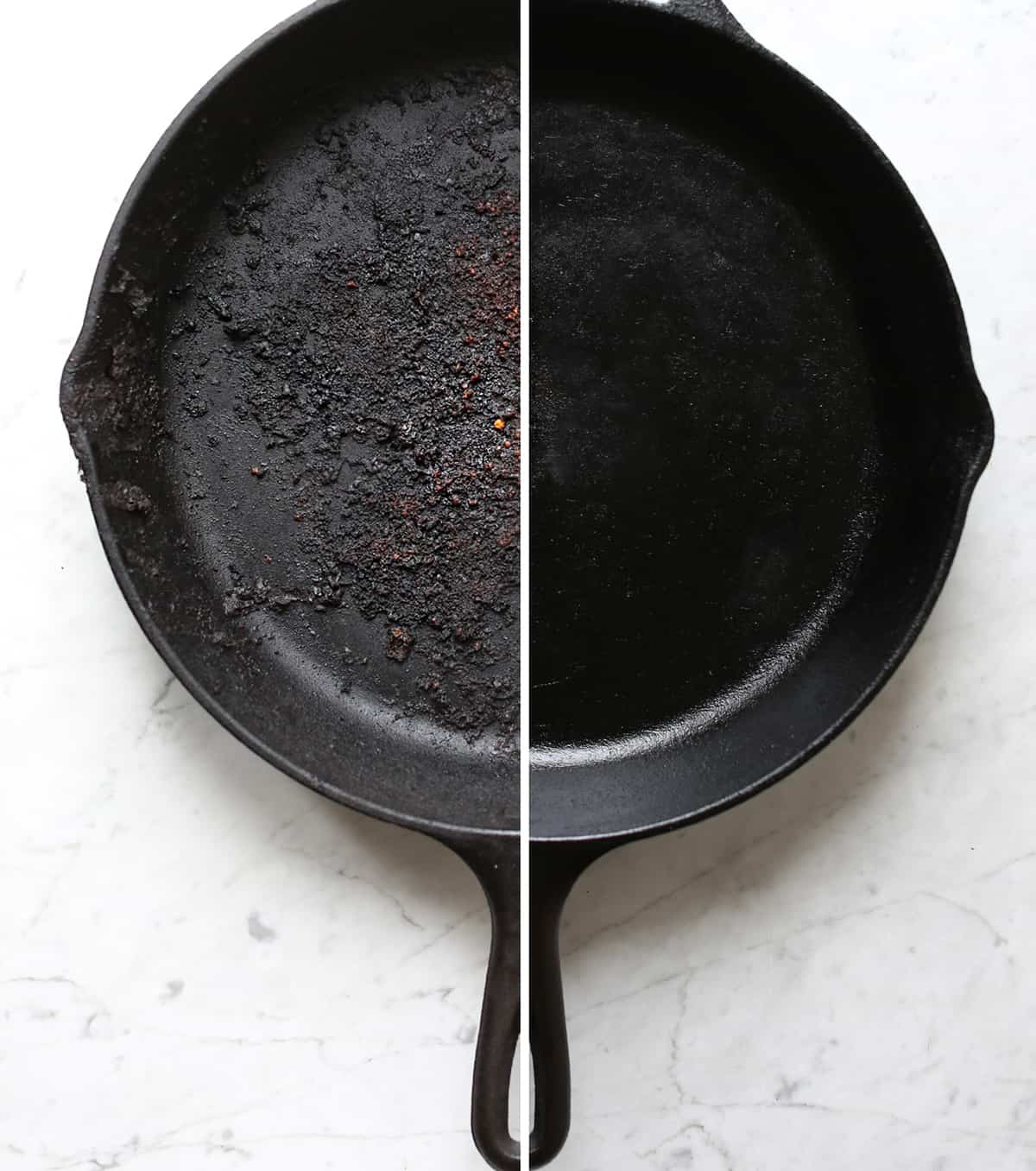Imagine this: you’re about to cook a delicious meal, but your cast iron skillet is rusty and food sticks to the surface. Frustrating, right?
Seasoning your skillet can change all that. It’s the secret to unlocking the full potential of your kitchen staple, transforming it into a non-stick wonder. You might think it’s a complicated process, but it’s actually simple and rewarding. In this guide, you’ll discover how to give your cast iron skillet the care it deserves, ensuring it lasts for generations.
Plus, a well-seasoned skillet not only enhances flavors but also adds an irresistible golden crust to your meals. Ready to learn how to create a perfectly seasoned skillet that will make cooking a joy? Read on and unleash the magic of your cast iron.

Credit: prolinerangehoods.com
Choosing The Right Oil
Selecting the right oil is crucial for seasoning a cast iron skillet effectively. Opt for oils with high smoke points, like vegetable or canola oil, to create a durable, non-stick surface. Proper oil choice ensures your skillet becomes a reliable kitchen tool.
Choosing the right oil to season your cast iron skillet can make a big difference in how well it performs. The oil you use not only affects the skillet’s non-stick properties but also its longevity. Picking the right one can make your cooking experience smoother and your meals tastier. So, how do you choose the best oil for the job?Understanding Smoke Points
The smoke point of an oil is crucial when seasoning cast iron. Oils with higher smoke points are ideal because they create a durable, non-stick layer. Vegetable oil, canola oil, and grapeseed oil are popular choices because of their high smoke points.Why Avoid Low Smoke Point Oils?
Oils like butter or olive oil have lower smoke points. They can burn easily, creating a sticky residue on your skillet. This residue can make food stick and might affect the taste of your dishes.Health Considerations
Consider the health benefits of the oil you choose. Some oils, like flaxseed oil, are rich in omega-3 fatty acids. However, they might not be the best for high-heat seasoning despite their nutritional benefits.Cost And Availability
Look at the cost and how easy it is to find the oil. While avocado oil is excellent for seasoning due to its high smoke point, it can be pricey. Canola oil is often more affordable and readily available, making it a practical choice for many.Personal Preferences And Experiences
Reflect on your own cooking style and preferences. I once seasoned my skillet with coconut oil, hoping for a tropical twist. The result was not ideal, leaving my skillet sticky. What works for one might not work for another, so experiment and find what suits your taste and cooking habits. Choosing the right oil is key to a well-seasoned skillet. Have you found an oil that works perfectly for you? Share your experiences and insights in the comments below!:max_bytes(150000):strip_icc()/How-to-Season-Cast-Iron-Skillet-3x2-1-bcd280f1703e47e0a59bb62e86a0d53a.png)
Credit: www.allrecipes.com
Step-by-step Seasoning Process
Gently scrub the cast iron skillet with warm, soapy water. Dry thoroughly to prevent rust. Apply a thin layer of vegetable oil, then bake upside down in a 350°F oven for one hour. Let cool completely. Repeat this process for a durable, non-stick surface that lasts.
Seasoning a cast iron skillet can seem like a daunting task, but it’s easier than you might think. This step-by-step seasoning process will help you create a non-stick surface on your skillet, ensuring your meals cook perfectly every time. Whether you’re a seasoned chef or a cooking newbie, these clear, straightforward steps will guide you through the process.Step 1: Gather Your Supplies
Before you start, make sure you have everything you need. You’ll require a clean cast iron skillet, some vegetable oil or melted shortening, and a few paper towels or a clean cloth. A baking sheet or aluminum foil will help catch any drips during the seasoning process.Step 2: Clean Your Skillet
Begin with a clean skillet. If it’s new, wash it with hot water and mild soap to remove any factory coating. For an older skillet, scrub away any rust or old food residues using a brush or steel wool. Rinse it thoroughly and dry it completely with a towel.Step 3: Apply The Oil
Pour a small amount of oil into the skillet. About a tablespoon should suffice. Use a paper towel or cloth to spread the oil evenly across the entire surface, including the bottom and handle. The goal is a thin, even layer.Step 4: Preheat Your Oven
Set your oven to 375°F (190°C). While it heats up, place a piece of aluminum foil or a baking sheet on the lower rack to catch any drips. This simple trick keeps your oven clean and saves you a future headache.Step 5: Bake The Skillet
Place your oiled skillet upside down on the upper rack of the oven. This prevents pooling of oil in the cooking surface. Bake it for about an hour. During this time, the oil will bond to the metal, creating that essential non-stick layer.Step 6: Let It Cool
Once the hour is up, turn off the oven and let the skillet cool inside. Allowing it to cool gradually in the oven helps the seasoning to set better. Once it’s cool, your skillet is ready for use or storage.Step 7: Repeat If Necessary
If your skillet isn’t as non-stick as you’d like, don’t worry. You might need to repeat the process a couple of times to build a stronger seasoning layer. Consistency is key here. Patience will pay off with a perfectly seasoned skillet. Remember the first time you cooked on your perfectly seasoned cast iron skillet? The way your eggs glided across the surface was worth every step, wasn’t it? With these easy-to-follow steps, you can achieve the same result, creating a reliable cooking tool for your kitchen adventures. Why not start today and transform your cooking experience?Maintaining Your Seasoned Skillet
Seasoning a cast iron skillet ensures it remains non-stick and rust-free. Begin by washing and drying it thoroughly. Then, apply a thin layer of vegetable oil over the surface and heat it in the oven. This process builds a protective coating, enhancing your skillet’s performance over time.
Maintaining your seasoned cast iron skillet is crucial to ensure its longevity and performance. A well-maintained skillet not only enhances your cooking experience but also preserves the rich flavors of your dishes. Let’s dive into some practical tips to keep your skillet in top shape, ensuring it remains your kitchen ally for years to come.Cleaning After Each Use
Always clean your skillet after every use. Use warm water and a gentle brush or sponge. Avoid soap, as it can strip away the seasoning. If food is stuck, try boiling a little water in the pan to loosen it. Once clean, dry it thoroughly with a towel to prevent rusting.Re-seasoning Regularly
Periodically, your skillet will need re-seasoning. This process reinforces the non-stick layer. Simply apply a thin coat of vegetable oil to the skillet. Heat it in the oven at 375°F (190°C) for an hour. Allow it to cool in the oven to complete the process.Storing Your Skillet Properly
Store your skillet in a dry place. Ensure it’s completely dry before storing to avoid rust. If stacking with other pans, place a paper towel between them. This helps protect the seasoning from scratches. How do you store your cast iron collection?Dealing With Rust
Rust can be a common issue but is easy to fix. Gently scrub the rusted area with a steel wool pad. Rinse and dry thoroughly. Once clean, re-season the skillet to restore its protective layer. Have you ever tackled rust on your skillet?Understanding The Importance Of Oil
Oil is your skillet’s best friend. It maintains the non-stick surface and prevents rust. Use oils with a high smoke point like canola or flaxseed. Apply a thin layer after each cleaning session. This simple step can extend the life of your skillet. Keeping a cast iron skillet in good condition isn’t just about maintenance; it’s a ritual that enhances your cooking adventures. Your skillet can last a lifetime with a little care and attention, becoming a family heirloom filled with stories. What tales will your skillet tell in the years to come?
Credit: abeautifulmess.com
Frequently Asked Questions
What Is The Proper Way To Season A Cast Iron Pan?
Clean the pan with soap and water. Dry thoroughly. Apply a thin layer of vegetable oil. Heat in the oven at 375°F for an hour. Let it cool completely. Repeat if needed for a smooth, non-stick surface. Proper seasoning enhances durability and prevents rust.
Should I Season Cast Iron At 350 Or 450?
Season cast iron at 450°F for best results. This temperature creates a durable, non-stick surface. Ensure the pan is clean and dry before applying oil. Bake it upside down in the oven for an hour to form a protective layer.
Regular seasoning maintains the pan’s performance and longevity.
How To Tell If Cast Iron Is Seasoned Correctly?
A well-seasoned cast iron has a smooth, non-sticky surface. It appears shiny and dark with a uniform coating. Food won’t stick, and it repels water. The skillet should heat evenly and release food easily. Properly seasoned cast iron enhances flavor and improves cooking performance.
Conclusion
Seasoning a cast iron skillet is simple and rewarding. A well-seasoned skillet enhances your cooking. It prevents food from sticking. Remember to clean it properly after use. Dry it completely to avoid rust. Apply a thin layer of oil regularly.
This helps maintain the non-stick surface. Use it often to improve seasoning. With care, your skillet lasts generations. Enjoy cooking with your versatile cast iron skillet. It’s a valuable kitchen tool. Happy cooking and delicious meals ahead!







